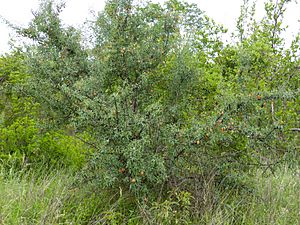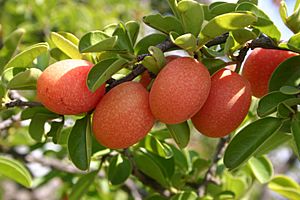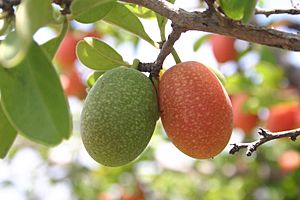Sourplum facts for kids
Quick facts for kids Sourplum |
|
|---|---|
 |
|
 |
|
| Habit and fruit in South Africa | |
| Conservation status | |
| Scientific classification | |
| Genus: |
Ximenia
|
| Species: |
caffra
|
The sourplum (Ximenia caffra) is a small tree or bush that isn't very bushy. It belongs to the Olacaceae plant family, which grows in many warm, tropical areas around the world. The sourplum tree is found mainly in South East Africa, in countries like Botswana, Kenya, Malawi, Mozambique, South Africa, Tanzania, Uganda, Zambia, and Zimbabwe.
Every year, the sourplum tree grows lots of fruits. These fruits are usually sour and leave a dry feeling in your mouth. They have a lot of potassium, which is good for you. The tree itself is quite strong; it can handle cold weather (frost) and long dry periods (drought). People use different parts of the tree, including the fruit, seeds, leaves, and roots. They are used for food, traditional medicine, or even as fuel. Sometimes, the trees are planted to create natural fences between pieces of land.
Contents
What the Sourplum Looks Like
The sourplum tree is usually a small tree or bush, about 2 meters (6.5 feet) tall. It has a crown (the top part with branches and leaves) that can look a bit messy. Sometimes, it can grow taller, up to about 6 meters (20 feet). Its branches can be smooth or have flat hairs, and they have small thorns at their bases.
The bark of the tree is grayish-brown to black and has long cracks in it. The leaves are simple, grow one after another, and are oval-shaped. When the tree flowers, the blossoms are greenish to creamy white. Sometimes, they can even have a pink or red tint.
The sourplum fruit itself is oval-shaped. Its skin is smooth and starts green, then turns orange or red when it's ripe. The inside flesh is also orange or red and becomes juicy when ready to eat. A sourplum fruit is about 3.5 cm (1.4 inches) long and 2.5 cm (1 inch) wide. The seed inside is smooth, oval, and yellow-brown to red. It's quite hard and about 2.5 cm (1 inch) long.
Where the Sourplum Grows
The sourplum can be found from Tanzania all the way down to KwaZulu-Natal in South Africa. You can spot it growing in forests, grasslands, on rocky hills, and sometimes even on termite mounds.
A similar type of tree, called the yellow plum (Ximenia americana), grows in the western United States.
How the Sourplum Grows
The sourplum tree usually flowers in September or October, which is during the dry season or when the rains are just starting. The fruits from these flowers are then ready in December or January, during the rainy season. This timing can change depending on the region. For example, in Tanzania, it might flower in January, May, July, and October, with fruits ready in October and January.
This tree can grow in places up to 2000 meters (about 6,500 feet) above sea level. It needs about 250 to 1270 mm (10 to 50 inches) of rain each year. It grows best in clay or loam soils. Once the seeds are planted, they usually start to sprout after 14 to 30 days. The tree grows at a moderate speed, about 0.5 meters (1.6 feet) per year.
Uses of the Sourplum Tree
Sourplum as Food
The sourplum fruit is sour, but you can eat it raw. It tastes best when it's a little bit overripe. Often, people soak the fruits in cold water. Then, they remove the skin and seed by pressing them. The soft fruit pulp left over can be mixed with mashed roots to make a type of porridge. The fruits can also be made into jam that can be stored for later. People also use sourplums to make desserts and jellies.
Sourplum Wood
The wood from the sourplum tree is hard and has a fine texture. It's often used as firewood because it burns well. It can also be used to make handles for tools, kitchen utensils, or for building things.
Sourplum Oil
To get oil from the sourplum, the seeds are roasted (cooked with dry heat) and then mashed. The oil is then taken out. This oil has many uses. It can make leather softer, oil bowstrings for hunting, or be used as a general ointment (a cream or balm). People also use the oil for their hair or on their skin to help with chafing (skin irritation). The oil can even be used as fuel for lamps.
Traditional Medicinal Uses
Different parts of the sourplum tree have been used in traditional remedies.
- Roots: Used to help with abscesses (pus-filled swellings), stomach aches, colic (tummy pain), malaria, coughs, and bilharzias (a type of parasitic infection). Some believe that eating the roots, pounded into a porridge, can help prevent women from becoming infertile.
- Bark: Used as a remedy for hookworm, chest pains, and general body pain.
- Seeds: Usually roasted and then pounded to get their oils, which are used on wounds as a soothing ointment.
- Leaves: Can be used to calm inflamed eyes and are said to help cure tonsillitis.
It's important to know that most of these traditional claims have not been fully proven by science, and more research is needed.
Sourplum for Animals
Birds and other animals enjoy eating the sourplum fruits. Several types of butterflies feed on the leaves of the tree. Many mammals also graze (eat grass and plants) on the leaves, especially during dry seasons when other food is scarce.
Sourplum Nutrition
The ripe sourplum fruit has a good amount of vitamin C (27%), protein (18%), and is very high in potassium. The seed itself is about 65% oil.
| Energy Value (kj/100 g) | Phosphorus (µg/g) | Calcium (µg/g) | Magnesium (µg/g) | Iron (µg/g) | Potassium (µg/g) |
|---|---|---|---|---|---|
| 1506 | 1674 | 29 | 459 | 366 | 41791 |
Things That Can Limit Sourplum Growth
Young sourplum trees (seedlings) might not survive long periods of drought, as they are not as strong against dryness as older trees. Also, wild animals often eat the leaves of the tree. During the dry season, animals will specifically choose to eat from the sourplum tree.
Helpful Information About Sourplum
The ripe fruit has a lot of tannins, which can make your mouth feel dry and leave a slightly bitter aftertaste. This dry feeling can get stronger if the fruit is stored for a long time. The seeds don't need any special storage conditions.
The sourplum tree can be used as a natural fence to mark land boundaries or create a perimeter. The plant can handle some frost and is quite resistant to drought. You can often find sourplum fruits being sold in small local markets.
Images for kids





